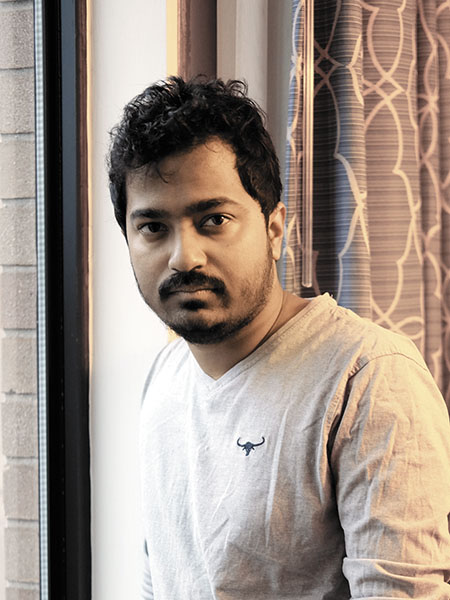Sept 2020 Vol 01 | Issue 02
Where the Birds Never Sing
Soumya Sankar Bose’s book review
by Nilayan Dutta
Soumya Sankar Bose’s Where the Birds Never Sing is a body of work on the Marichjhapi massacre, the forcible eviction in 1979 of Bengali refugees on Marichjhapi Island in Sundarban, West Bengal, and the subsequent death of thousands by police gunfire, starvation, and disease.
Review
From its onset, the project was not visualized in a form of traditional documentary photography. It was not possible to replicate an incident that took place unerringly forty years ago. Neither had it followed the typical genus of docu-fiction method that widely applied mostly in movies. One can classify this work as the photographer’s journey through a history of his own origin. The texts written by Soumya Sankar do not narrate the story for the images in the book, however, these are descriptions of different events that Soumya experienced in his life throughout the period of this project was made. The photograph on the book-jacket is theatrical, we see a woman stand by a tree with a bird face mask. And the cover page of the book displays an image of a hand that holding a gun. When we see these two images together it becomes a visual reference that indicating power, violence, hiding, misery, refuge and vulnerability, where the black background of both the photographs denotes about a darker milieu of the whole story, relating to the title of the book ‘Where the Birds Never Sing’.
The small inserts used in between some pages represent a real-time and historical documented part of the incident that took place in late 70’s in Bengal, this idea of inserts show us the artistic creation accomplished by Barnali, the designer of the book. The textual narrative written in the book by Annu Jalais is from her academic research that converses about the Sundarban and its inhabitants, which strongly holds the connecting cords of the project.
By mentioning to the history of India and division of Bengal in two separate countries in 1947, Soumya does not accept the term refugee applied to these people who killed, died or affected by Marichjhapi massacre. The relation between the subject and the artist can easily be found when we listen to the talk by Soumya where he explains how he had grown-up in listening to the stories of his grandfather and his exodus, who also was came from East Pakistan (now Bangladesh) to India being a victim of the partition.
Nilayan Dutta
Text: Aditya Kumar | Soumya Sankar Bose | Annu Jalais
Design: Barnali Bose
Pages: 148 pages
ISBN: 978-1-5136-6415-6
This Project is supported by The Foundation for Indian Contemporary Art (Amol Vadehra Art Grant), India foundation for the Arts, Magnum Foundation, Henry Luce Foundation & World Press Photo.
About the Project:
Where the Birds Never Sing is a body of work on the Marichjhapi massacre, the forcible eviction in 1979 of Bangladeshi refugees on Marichjhapi Island in Sundarban, West Bengal, and the subsequent death of thousands by police gunfire, starvation, and disease.
After the partition of Bengal in 1947 many lower caste Bengalis who fled East Pakistan were aggressively sent to the infertile, inhospitable land of Central India. In 1977, the Left Front government came to power promising their refugee supporters to settle in West Bengal and they subsequently moved to Marichjhapi Island. But the government reneged on its promise, fearing that an influx of refugees might jeopardise the prospects of the state’s economic recovery, and started to forcibly send them back to Central India.





Survivors claim that on the morning of 31 January 1979, when some women tried to row boats to the next island to fetch drinking water, grains and medicine, the police rammed their launches into the boats and drowned all three. People who took boats into the river to save the drowning women were fired on by the police.
Thousands of refugees seeking their final home stayed in Marichjhapi, for the next year and a half. It is close to impossible to trace the precise number of people that died in process during the exodus from central Indian camps to settlement in Marichjhapi, and the eventual police eviction drive sending them back to the camps.
Bose, over the last two years, has been researching and re-enacting some memories of the survivors in specific locations, as there is very little written record of the incident. Through the intricate weaving of facts and fiction of existing oral histories of the real survivors, he brings to light several perspectives of the same narrative, forming a cryptic framework of this problematic history that is facing slow erasure from the memory of people.

Soumya Sankar Bose
Born and brought up in Midnapore, a small town near Kolkata (India). Soumya was awarded Magnum Foundation’s Social Justice Fellowship for my Full Moon on a dark night project and in 2018 has received Magnum Foundations’ Migration and religion grant. His other projects are also recipient of The Foundation for Indian Contemporary Art’s Amol Vadehra Art Grant, The Agroecology Fund, Goethe-
Institute / Max Mueller Bhavan’s Five Million Incidents, Henry Luce Foundation’s grant and India Foundation for the Arts grant thrice. In 2019, he was one of the participants of World Press Photo’s Joop Swart Masterclass. Now live and work from Kolkata and is represented by Gallery Experimenter. His work has reviewed by The New York Times, NPR, Granta, Indian Express,The Telegraph, BBC Online, Platform, scroll.in, The caravan, Conde Nast etc. And has been shown in Houston Center For Photography, Indian Art Fair, Sepia Eye (New York), Goethe-Institut, Experimenter, Delhi Photo Festival and in many more places.

Nilayan Dutta
Nilayan Dutta is a documentary photographer and founder of ‘School of Visual Appreciation Kolkata’.

